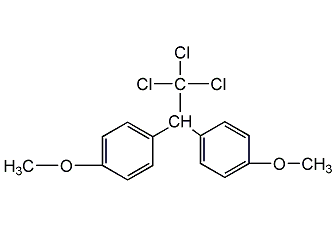
Structural formula
| Business number | 01H1 |
|---|---|
| Molecular formula | C16H15Cl3O2 |
| Molecular weight | 345.65 |
| label |
1,1,1-Trichloro-2,2-bis-p-methoxyphenylethane, 1,1,1-Trichloro-2,2-bis(4-methoxyphenyl)ethane, methoxychlor, Marlate,Metox, 1,1,1-Trichloro-2,2-di(4-methoxyphenyl)ethane, 2,2-Bis(4-methoxyphenyl)-1,1,1-trichloroethane, DMDT, Organochlorine pesticides |
Numbering system
CAS number:72-43-5
MDL number:MFCD00000803
EINECS number:200-779-9
RTECS number:KJ3675000
BRN number:2057367
PubChem number:24896655
Physical property data
1. Properties: The original drug is white or creamy yellow block or flake solid
2. Density (g/mL, 25/4℃): 1.41
3 . Relative vapor density (g/mL, air=1): Uncertain
4. Melting point (ºC): 86-88 (pure product), industrial product is about 77℃
5. Boiling point (ºC, normal pressure): Uncertain
6. Boiling point (ºC, 5.2 kPa): Uncertain
7. Refractive index: Uncertain
8. Flash point (ºC): 11
9. Specific rotation (º): Uncertain
10. Autoignition point or ignition temperature (ºC): Uncertain Confirm
11. Vapor pressure (kPa, 25 ºC): Uncertain
12. Saturated vapor pressure (kPa, 60 ºC): Uncertain
13 . Heat of combustion (KJ/mol): Uncertain
14. Critical temperature (ºC): Uncertain
15. Critical pressure (KPa): Uncertain
16. Log value of oil-water (octanol/water) partition coefficient: Uncertain
17. Explosion upper limit (%, V/V): Uncertain
18. Explosion Lower limit (%, V/V): Uncertain
19. Solubility: Easily soluble in benzene, xylene and other organic solvents, soluble in ethanol and petroleum, insoluble in water (0.1mg /L)
Toxicological data
Acute oral administration in ratsLD50 > 10000mg/kg (6000mg/kg), acute oral administration in rats SkinLD50 >10000mg/kg. The no-effect dose in rats was 500 mg/kg for 30 days, and the no-effect dose in the 2-year feeding test was 200 mg/kg. The no-effect dose in the 1-year feeding test for dogs was 300 mg/kg. Animal tests showed no teratogenic, carcinogenic, or mutagenic effects. MallardLD50 >2000mg /kg > Crane and quail > 5000mg /kg > Pheasant > 5000mg /kg. Rainbow cicadaLC50 is 45μg/L (24h), bee LDS . It is 165.5μg/piece.
Ecological data
None
Molecular structure data
None
Compute chemical data
1. Reference value for hydrophobic parameter calculation (XlogP): None
2. Number of hydrogen bond donors: 0
3. Number of hydrogen bond acceptors: 2
4. Number of rotatable chemical bonds: 4
5. Number of tautomers: none
6. Topological molecule polar surface area 18.5
7. Number of heavy atoms: 21
8. Surface charge: 0
9. Complexity: 279
10. Number of isotope atoms: 0
11. Determine the number of atomic stereocenters: 0
12. Uncertain number of atomic stereocenters: 0
13. Determine the number of chemical bond stereocenters: 0
14. Number of uncertain chemical bond stereocenters: 0
15. Number of covalent bond units: 1
Properties and stability
Mildly irritating to rabbit skin and eyes.
Storage method
Store in a cool, ventilated and dry place, and do not mix with food, feed, beverages and other items.
Synthesis method
Prepared from the condensation of anisole and trichloroacetaldehyde.
Methoxychlor is produced by condensing anisole and trichloroacetaldehyde in the presence of fuming sulfuric acid or aluminum trichloride.
Purpose
1. An organochlorine pesticide. This product is a non-systemic contact and stomach poisoning insecticide with slight aphidicide or acaricidal activity. Its biological activity range is roughly the same as that of DDT. Because it has little or no tendency to accumulate in body fat or be secreted into milk, it is recommended for fly control in dairies and dairy cows. This product can also be used to prevent and control household sanitary pests, animal ectoparasites, vegetable and fruit tree pests, replacing DDT. The maximum allowable residual amount is: 2 mg/kg for grain, 14 mg/kg for fruit trees, and 100 mg/kg for feed. The ban period is 7 to 21 days before harvest. For example, when using 25% EC to control poplar loopers and aphid weevils in poplar and jujube trees, spray at 625 to 1250 mg/L.
2.Organochlorine pesticides. It has contact and stomach poisoning effects, no systemic effect, wide insecticidal spectrum, low toxicity to humans and animals, no cumulative effect in the organism, and is easily decomposed by multifunctional oxidase and converted into water-soluble non-toxic excreta. It can be used on field crops, fruit trees, vegetables and other crops to control corn borers, bridge-building insects, bean beetles, pea weevils, fruit tree borers, codling moths, Japanese beetles, small weevils, canopy caterpillars, and fruitFlies, leafhoppers, stink bugs, vegetable leaf flea beetles, diamondback moths, cucumbers, seed flies and other pests. It can also be used to control ectoparasites and sanitary pests in livestock.


